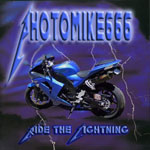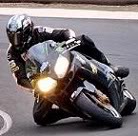Front Suspension Question
22 posts
• Page 1 of 2 • 1, 2
Front Suspension Question
The Yamaha Fizzer 250 I just picked up has an abnormal amount of softness about its front end. IE: Lean it back off the side stand and under its own weight it drops 30mm. it doesn't appear to show any signs of damping either - front end like a pogo stick.
Question is, and I intended to do it anyway, will replacing the oil stiffen up the front end entirely and could it be because the levels are low that it behaves this way? I cracked the bleed screw at the bottom of the fork leg and got a sample which appears not to contain moisture - just more of a thin used oil. From what I can see the fork seals are not leaking.
Replacing the oil - which probably has never been done since it left the factory 18 years ago - will no doubt improve the dampening properties but will it actually improve such things as the sag I am experiencing?
Any ideas or debates welcome as I have never had much to do with rebuilding front suspension. I know how it works but I have never experienced sittuations when it hasn't, if you know what I mean?
Question is, and I intended to do it anyway, will replacing the oil stiffen up the front end entirely and could it be because the levels are low that it behaves this way? I cracked the bleed screw at the bottom of the fork leg and got a sample which appears not to contain moisture - just more of a thin used oil. From what I can see the fork seals are not leaking.
Replacing the oil - which probably has never been done since it left the factory 18 years ago - will no doubt improve the dampening properties but will it actually improve such things as the sag I am experiencing?
Any ideas or debates welcome as I have never had much to do with rebuilding front suspension. I know how it works but I have never experienced sittuations when it hasn't, if you know what I mean?
I got a sweater for my birthday. I realy wanted a moaner or a screamer.


-

Slow and wobbly - KSRC Contributor

- Posts: 1541
- Joined: Sun Sep 11, 2005 8:51 am
- Location: Melbourne
- Bike: Scooter
- State: Victoria
Re: Front Suspension Question
I don't know a great deal about the build of front shocks, but they seem to be made of damper, spring and valvues (simplistic view). I would assume the damper will degenerate over time, but can see the valvues wearing to allow more volume to flow and springs become softer over time. It may be worth throwing in new springs, and getting them set to your weight. How is the rear shock? A rear going pogo will also affect the front end? Not as cheap to rebuild a rear shock, but might be worth checking.
--------------------------------------------------------------------------------------------------------------
07 ZX10R since new, tracky TBA, KX450F, 87 CR250 restoration, GT MTB - I've got serious thrill issues, dude
07 ZX10R since new, tracky TBA, KX450F, 87 CR250 restoration, GT MTB - I've got serious thrill issues, dude
-

photomike666 - Apprentice Post Whore :-)

- Posts: 5956
- Joined: Sat Jan 15, 2005 12:01 am
- Location: Melbourne
- Bike: ZX10R
- State: Victoria
Re: Front Suspension Question
If its sagging in its own weight that much changing to thicker oil won't really help, but it will slow the sagging down. It will take longer to sag as the oil needs to get thru the valves. I just fixed up the misses forks on her zzr 250 and as they have no adjustments the only way to increase preload is either new springs or spacers...... I put in 3 washers on either side and with some nice fresh oil, at a slighlty higher level than std, its much better...
Dave
2010 Z1000
ex bikes
05 ZX-10R Race Bike - No.77
95 ZXR750R M Race Bike - No. 75
98 ZX9R Race Bike - No. 000
zx6r, zx7r, GPX750, GPX500, lots of KX's.

I ride way too fast to worry about cholesterol
2010 Z1000
ex bikes
05 ZX-10R Race Bike - No.77
95 ZXR750R M Race Bike - No. 75
98 ZX9R Race Bike - No. 000
zx6r, zx7r, GPX750, GPX500, lots of KX's.

I ride way too fast to worry about cholesterol
-

MadKaw - Administrator

- Posts: 9670
- Joined: Tue Apr 20, 2004 4:33 pm
- Location: Windsor or the Creek..
- Bike: ZX10R
- State: New South Wales
Re: Front Suspension Question
MadKaw wrote:If its sagging in its own weight that much changing to thicker oil won't really help, but it will slow the sagging down. It will take longer to sag as the oil needs to get thru the valves. I just fixed up the misses forks on her zzr 250 and as they have no adjustments the only way to increase preload is either new springs or spacers...... I put in 3 washers on either side and with some nice fresh oil, at a slighlty higher level than std, its much better...
Thats what I thought
I got a sweater for my birthday. I realy wanted a moaner or a screamer.


-

Slow and wobbly - KSRC Contributor

- Posts: 1541
- Joined: Sun Sep 11, 2005 8:51 am
- Location: Melbourne
- Bike: Scooter
- State: Victoria
Re: Front Suspension Question
20c pieces look like the cheapest way. Well 20c each and the right size. 
I got a sweater for my birthday. I realy wanted a moaner or a screamer.


-

Slow and wobbly - KSRC Contributor

- Posts: 1541
- Joined: Sun Sep 11, 2005 8:51 am
- Location: Melbourne
- Bike: Scooter
- State: Victoria
Re: Front Suspension Question
Slow and wobbly wrote:20c pieces look like the cheapest way. Well 20c each and the right size.
everything old is new again.....
back in the 70's/80's, 20c pieces were the weapon of choice for increasing pre-load. About $1.60 worth in each leg fixed up most z900's
".....shut the gate on this one Maxie......it's the ducks guts !!............."
-

Gosling1 - Team Donut

- Posts: 13823
- Joined: Mon Jun 20, 2005 9:30 pm
- Location: Anarchy Road
- Bike: Z900
- State: ACT
Re: Front Suspension Question
Isn't it amusing though that a washer of the same dimensions would cost 50c?
I got a sweater for my birthday. I realy wanted a moaner or a screamer.


-

Slow and wobbly - KSRC Contributor

- Posts: 1541
- Joined: Sun Sep 11, 2005 8:51 am
- Location: Melbourne
- Bike: Scooter
- State: Victoria
Re: Front Suspension Question
thats a free-market democracy for ya !

and in shocking news, here's some on-topic advice....
the stock springs are fucked. Sagged to buggery after 18 years, and they weren't that good to start with ( old Yammie springs were never much chop really) - so get some new springs and you should be sweet. If you just bump up the pre-load with the sagged springs, the front-end will handle even worse that it does now - it will bottom-out at the slightest provocation, as adding pre-load to sagged springs will just reduce travel even further........

and in shocking news, here's some on-topic advice....
the stock springs are fucked. Sagged to buggery after 18 years, and they weren't that good to start with ( old Yammie springs were never much chop really) - so get some new springs and you should be sweet. If you just bump up the pre-load with the sagged springs, the front-end will handle even worse that it does now - it will bottom-out at the slightest provocation, as adding pre-load to sagged springs will just reduce travel even further........
".....shut the gate on this one Maxie......it's the ducks guts !!............."
-

Gosling1 - Team Donut

- Posts: 13823
- Joined: Mon Jun 20, 2005 9:30 pm
- Location: Anarchy Road
- Bike: Z900
- State: ACT
Re: Front Suspension Question
Slow and wobbly wrote:Isn't it amusing though that a washer of the same dimensions would cost 50c?
Truth be known, the zzr 250 has a 20 coin in each leg and 2 washers in each... I bought a few washers, one size was too small, the other too big... So used a 20 cent on top of the spacer and then used the smaller washers, cause I had em...
Luckily the big ones also work as ride height adjusters on the 10...
The washers were 6 for $1...
Dave
2010 Z1000
ex bikes
05 ZX-10R Race Bike - No.77
95 ZXR750R M Race Bike - No. 75
98 ZX9R Race Bike - No. 000
zx6r, zx7r, GPX750, GPX500, lots of KX's.

I ride way too fast to worry about cholesterol
2010 Z1000
ex bikes
05 ZX-10R Race Bike - No.77
95 ZXR750R M Race Bike - No. 75
98 ZX9R Race Bike - No. 000
zx6r, zx7r, GPX750, GPX500, lots of KX's.

I ride way too fast to worry about cholesterol
-

MadKaw - Administrator

- Posts: 9670
- Joined: Tue Apr 20, 2004 4:33 pm
- Location: Windsor or the Creek..
- Bike: ZX10R
- State: New South Wales
Re: Front Suspension Question
OK - we are discussing a shuttle valve fork. Very easy to comprehend:
Oil is forced through a bunch of holes in what might look to some like a baffled tube - or like the end of them WW2 machine guns - it gets pushed by a sloppily fitted plastic ring, which inevitably wears. But let's assume that this ring - this "shuttling band" (the ring that is) - is el-perfecto, and has a wonderful seal on the tube (which it won't and never did!). The design is out-dated and was never really that brilliant an idea...
A damper-rod or shuttle valve fork relies on damping created via the velocity squared route: oil goes through holes (remember) just like a bunch of people leaving a concert hall - one or two through the doorway is really easy; but when someone shouts "fire", well the whole kaboodle jams solid as all the big and small alike try to exodus simultaneously - right, so suspension... simply put, ya get easy and piss poor under-controlled movement or oscillation, until the speed in there gets up enough to do something to the holes - damping.
Problem is that it can be sloppy when initially braking and changing direction - load on, load off front - and then harsh when it hits a bump; like a petrol station forecourt curb for example... So, really one gets the worst of it all.... Thicker oil will do something about the initial timing of damping - like when it starts - but will only make the "doorway" to the concert hall jam up with even fatterer people!!! ....so we have the variable orificia damped system nowadays, commonly known as a cartridge fork - where shims and port type (etc etc) combined with oil sort, go to timing the control from start to finish and hopefully gain some good stuff and lose the bad that was there with the shuttle valve design!
Preloading a spring only delays commencement of movement - the rate (of the spring) will return to being as it normally would (0.7 kgf per mm for EG) once the "break-point" is surpassed (25mm of preloading on a 0.7 = 17.5kgs x 2 legs). Preloading will also only reduce travel or stroke in the fork or damper from the perspective that it gets less of an initial "run-up" at things - the stroking or bottoming in a fork is controlled by other factors - or should be if being doctored appropriately!!!
The only way that preloading a spring could change a 120mm stroke fork to being restricted to 100mm (for EG) travel would be if enough of the active-coils were closed up that they bound together, and movement therefore, became impossible - if the cap at the fork top is having to be compressed a lot so as to get the staunchion to join it from using excessive preloading tube, then really, a set of springs would be the go!!!
If you have a bike with shuttle valve fork, then usually if the budget does not extend to retro-fitting cartridges from another type of bike, then I fit some tuneable valve bodies in on top of the shuttle valve seats, and completely annihilate the old method of forming damping (V2) - this route by way of a parts grabber and a few cunning tricks internally allows the fork to gain compression adjustment, whilst catching/controlling the conserved energy from the spring easier by way of rebound damping.
Anyways, sorry for prattling on....
Oil is forced through a bunch of holes in what might look to some like a baffled tube - or like the end of them WW2 machine guns - it gets pushed by a sloppily fitted plastic ring, which inevitably wears. But let's assume that this ring - this "shuttling band" (the ring that is) - is el-perfecto, and has a wonderful seal on the tube (which it won't and never did!). The design is out-dated and was never really that brilliant an idea...
A damper-rod or shuttle valve fork relies on damping created via the velocity squared route: oil goes through holes (remember) just like a bunch of people leaving a concert hall - one or two through the doorway is really easy; but when someone shouts "fire", well the whole kaboodle jams solid as all the big and small alike try to exodus simultaneously - right, so suspension... simply put, ya get easy and piss poor under-controlled movement or oscillation, until the speed in there gets up enough to do something to the holes - damping.
Problem is that it can be sloppy when initially braking and changing direction - load on, load off front - and then harsh when it hits a bump; like a petrol station forecourt curb for example... So, really one gets the worst of it all.... Thicker oil will do something about the initial timing of damping - like when it starts - but will only make the "doorway" to the concert hall jam up with even fatterer people!!! ....so we have the variable orificia damped system nowadays, commonly known as a cartridge fork - where shims and port type (etc etc) combined with oil sort, go to timing the control from start to finish and hopefully gain some good stuff and lose the bad that was there with the shuttle valve design!
Preloading a spring only delays commencement of movement - the rate (of the spring) will return to being as it normally would (0.7 kgf per mm for EG) once the "break-point" is surpassed (25mm of preloading on a 0.7 = 17.5kgs x 2 legs). Preloading will also only reduce travel or stroke in the fork or damper from the perspective that it gets less of an initial "run-up" at things - the stroking or bottoming in a fork is controlled by other factors - or should be if being doctored appropriately!!!
The only way that preloading a spring could change a 120mm stroke fork to being restricted to 100mm (for EG) travel would be if enough of the active-coils were closed up that they bound together, and movement therefore, became impossible - if the cap at the fork top is having to be compressed a lot so as to get the staunchion to join it from using excessive preloading tube, then really, a set of springs would be the go!!!
If you have a bike with shuttle valve fork, then usually if the budget does not extend to retro-fitting cartridges from another type of bike, then I fit some tuneable valve bodies in on top of the shuttle valve seats, and completely annihilate the old method of forming damping (V2) - this route by way of a parts grabber and a few cunning tricks internally allows the fork to gain compression adjustment, whilst catching/controlling the conserved energy from the spring easier by way of rebound damping.
Anyways, sorry for prattling on....
-

zenodamper - Warming up

- Posts: 85
- Joined: Tue Jun 12, 2007 9:37 am
- Location: Lidcombe
- Bike: ZX6R
- State: New South Wales
Re: Front Suspension Question
Dont let them rip ya in the shops, Ive seen 20c spacers go for as little as 50c each if ya shop around..
- hoffy
- Team Barge

- Posts: 8744
- Joined: Sun Oct 30, 2005 10:59 am
- Bike: Z1000
- State: New South Wales
Re: Front Suspension Question
Right. No manual, no prior experience, and no bloody idea 
Forks are on the bench. First problem is there isn't a top cap to remove. Instead there is a pressed metal insert held in by a retaining clip - just a spring ring like a circlip but with no ears to be able to grasp it and compress it. Fairly well corroded as well because of water getting past the rubber plug what sits atop.
I have undone the little drain screw at the bottom of the fork legs and released the oil. On the Rh leg it drained easily, but on the LH it has only released a small amount of oil and some small chrome flakes came with it. There is still oil in the LH leg because I can hear it but no amount of bouncing up and down will force it out.
Now I have endeavoured to undo the 6mm allen head bolt at the bottom of the fork legs but all I have succeeded in doing is twisting up three 6mm hex keys into the form of licorice
So what now ? If I release the damping rod will that allow the fork leg to come apart without the need to remove the top retaining ring? If I somehow manage to remove the retaining ring am I going to get shot in the head by cap and spring, and then never be able to get the whole shitfight back together? On the Rh leg - which seems to operate fine am I able to replace the oil back through the drain hole and not bother about pulling it apart? The LH leg will have to come apart as 1. it doesn't move particularly smoothly 2. there is obviously something NQR going on inside.
Heading off down the street now to pick up a 6mm impact hex.
Forks are on the bench. First problem is there isn't a top cap to remove. Instead there is a pressed metal insert held in by a retaining clip - just a spring ring like a circlip but with no ears to be able to grasp it and compress it. Fairly well corroded as well because of water getting past the rubber plug what sits atop.
I have undone the little drain screw at the bottom of the fork legs and released the oil. On the Rh leg it drained easily, but on the LH it has only released a small amount of oil and some small chrome flakes came with it. There is still oil in the LH leg because I can hear it but no amount of bouncing up and down will force it out.
Now I have endeavoured to undo the 6mm allen head bolt at the bottom of the fork legs but all I have succeeded in doing is twisting up three 6mm hex keys into the form of licorice
So what now ? If I release the damping rod will that allow the fork leg to come apart without the need to remove the top retaining ring? If I somehow manage to remove the retaining ring am I going to get shot in the head by cap and spring, and then never be able to get the whole shitfight back together? On the Rh leg - which seems to operate fine am I able to replace the oil back through the drain hole and not bother about pulling it apart? The LH leg will have to come apart as 1. it doesn't move particularly smoothly 2. there is obviously something NQR going on inside.
Heading off down the street now to pick up a 6mm impact hex.
I got a sweater for my birthday. I realy wanted a moaner or a screamer.


-

Slow and wobbly - KSRC Contributor

- Posts: 1541
- Joined: Sun Sep 11, 2005 8:51 am
- Location: Melbourne
- Bike: Scooter
- State: Victoria
Re: Front Suspension Question
Not knowing how the forks are set up on the Fizzer I am probably best served leaving this to James. However in his absence my understanding is that the fork top has to be removed along with the spring in order to release the lower hex bolt! Most shops have a special tool which goes down inside the fork to hold the inner nut and remove the offending licourice twisting allen key gremlin!! 
I don't have a special tool, but have done it with a Rattle gun when push came to shove.
Confirm it with James, but I wouldn't touch the bottom allen key until I released that top cap!
I don't have a special tool, but have done it with a Rattle gun when push came to shove.
Confirm it with James, but I wouldn't touch the bottom allen key until I released that top cap!
"I hate to advocate drugs, alcohol, violence or insanity to anyone, but they've always worked for me" Hunter S. Thompson.
There are really only two questions in life. 1.Which way do i go? 2.What is the lap record?
There are really only two questions in life. 1.Which way do i go? 2.What is the lap record?
-

Strika - VIP MEMBER

- Posts: 8373
- Joined: Tue Feb 01, 2005 8:02 am
- Location: Melbourne
- Bike: Yamaha
- State: Victoria
Re: Front Suspension Question
I got a sweater for my birthday. I realy wanted a moaner or a screamer.


-

Slow and wobbly - KSRC Contributor

- Posts: 1541
- Joined: Sun Sep 11, 2005 8:51 am
- Location: Melbourne
- Bike: Scooter
- State: Victoria
Re: Front Suspension Question
Put the 6mm hex-in-socket into the base there, and bash it a good few times - there is highly likely either corrosion/oxidising/glue on the thread, and you really do not want a situation whereby the whole lot turns together internally together - gets difficult to undo! Rattle guns help here as well.... Rememeber that the spring's preloaded tension will partially assist with the undoing process. 
There is no major need to go and release the damper rod if you only desire to change oil, spring, or spring preload - though I would be thoroughly cleaning out the sludge myself in the parts washer.... up to you!
There is no major need to go and release the damper rod if you only desire to change oil, spring, or spring preload - though I would be thoroughly cleaning out the sludge myself in the parts washer.... up to you!
-

zenodamper - Warming up

- Posts: 85
- Joined: Tue Jun 12, 2007 9:37 am
- Location: Lidcombe
- Bike: ZX6R
- State: New South Wales
22 posts
• Page 1 of 2 • 1, 2
Return to General Tech & Performance Talk
Who is online
Users browsing this forum: No registered users and 24 guests
